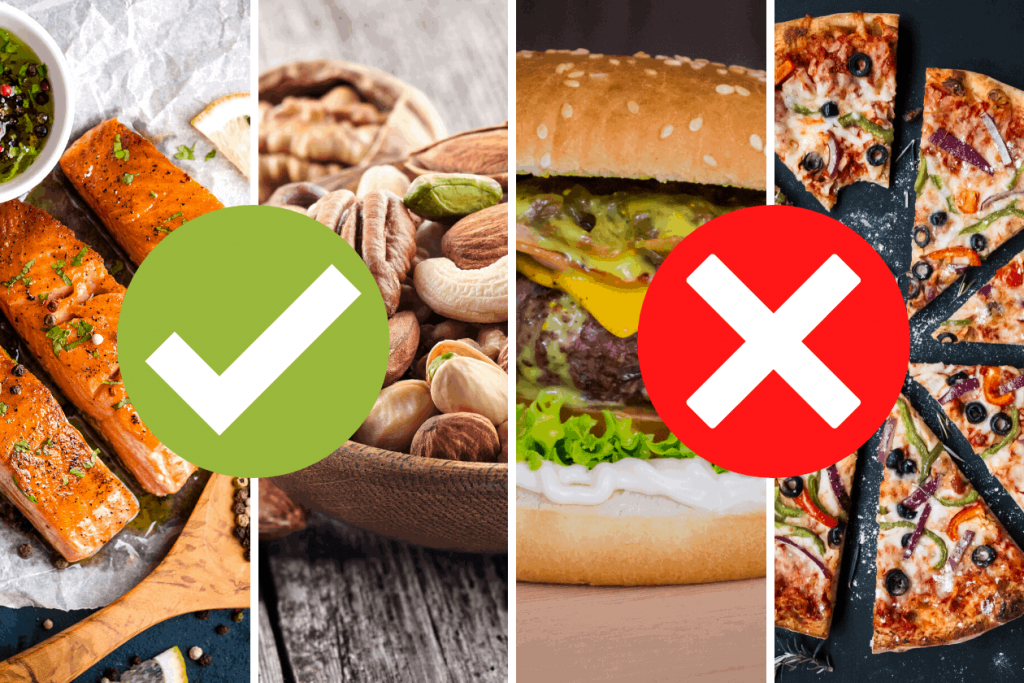
It is important to include at least three to five servings of fruits and vegetables in your daily diet during the first trimester. The best choices for green vegetables are broccoli, spinach and green peas. Spinach is particularly beneficial during this time as it is rich in folic acid. Broccoli contains lots of iron which is good for the baby. Broccoli is safe for everyone, although it is not recommended by hypothyroid women. Avoid tomatoes, sweet potatoes, avocado, and green bell peppers in the first trimester.
Whole grains and lentils are essential for a healthy diet in the first trimester. These will provide the vital nutrients your baby requires to grow and develop. Protein is essential for the first three months of pregnancy, so make sure you get two servings daily. These could include eggs, dairy products, fish, chicken, and nuts. These are the top foods to avoid during this time.
A prenatal nutritionist is the best way to ensure that your baby's diet is healthy. A nutritionist can help determine the best diet for you, and what you can eat while pregnant. You can ensure a happy birth and healthy baby by following a healthy diet. It's an exciting time to be a mother-to-be in the first trimester.

Aim to avoid processed meats and fatty foods if you're a first-time mom. A developing baby can be exposed to raw meats and deli meats. Make sure they are cooked to a boiling hot temperature before eating. You should avoid shellfish, sashimi, as well as sushi. Mercury-rich fish should be avoided. These are just a few of the reasons why you should avoid eating raw eggs, oysters and shark.
Although it might be tempting to eat oily and fatty fish, they are not recommended. They can make your baby's stomach sick. This is a normal reaction to hormones, but you should also consider your pregnancy's stage to know what kinds of food to eat. The most important thing to do is to eat a wide variety of healthy foods. It is important to eat a variety vegetables and fruits and avoid fatty meats.
Your baby's growth is greatest in the first trimester. You should eat lots of protein. Prenatal vitamins are recommended for pregnant women who plan to have babies. You should also eat plenty of iron-rich foods. You should eat lean meats and fish because they contain more iron than other meats. Avoid fried foods and processed foods during the first trimester.
While choosing the foods to eat during the first trimester, remember to check labels on your food. You can eat most meats during the second quarter, but there are certain foods you should avoid. Listeria bacteria is found in a number of unpasteurized dairy products. This can lead to infection in the unborn child. You should also avoid eating soft cheeses with a white coating on the outside.

Also, avoid shellfish and raw fish. They can cause food-borne illnesses. Avoid raw shellfish, as they may contain harmful bacteria. You should cook these foods to kill the harmful bacteria. To protect your baby, it is important to use pasteurized dairy products. There are still options to purchase pasteurized dairy products if you are unable find them in your local grocery store. Non-pasteurized products are also recommended to ensure safety for your baby.
Your nutrition is another important aspect of the first trimester. Not only should you eat a healthy meal, but also avoid processed foods. A great source of protein is fresh fruit and vegetables. Folates should be included in your daily diet. These folates are vital for the development of the baby’s nervous system. The U.S. Public Health Service recommends that pregnant ladies consume 400 micrograms of Folic Acid per day.
FAQ
Here are 7 ways to live a healthy lifestyle.
-
You should eat right
-
Exercise regularly
-
Sleep well
-
Make sure to drink plenty of water.
-
Get enough sleep
-
Be happy
-
Smile often
What is the best way to live a healthy lifestyle?
Living a healthy lifestyle is one that encourages you to eat well, exercise regularly, get enough sleep, and avoids stress. If you follow these guidelines, you will be able to lead a long and healthy life.
Start small by changing your diet and exercising routine. To lose weight, you can start walking for 30 mins each day. Or, if you want to get more active, take up swimming or dancing. You can also sign up for an online fitness program, such as Strava and Fitbit. This will track your activity.
How do I find out what's best for me?
You must listen to your body. Your body will tell you how much exercise, nutrition, and sleep you need. It's important to pay attention to your body so you don't overdo things. Pay attention to your body, and ensure that you are doing all you can to keep yourself healthy.
What is the difference between a virus and a bacterium?
A virus is an organism microscopic that can't reproduce outside its host cells. A bacterium (or single-celled organism) reproduces by splitting itself into two. Viruses have a very small size (about 20 nanometers), while bacteria is larger (up to one micron).
Viruses are often spread through contact of infected bodily fluids like saliva, urine or semen. Bacteria are usually spread through direct contact with contaminated objects or surfaces.
Viruses can enter our bodies through cuts, scrapes, bites, or other breaks in the skin. They may also enter through the nose, mouth, eyes, ears, vagina, rectum , or anus.
Bacteria can get into our bodies through cuts, scrapes and burns, insect bites, or other skin breaks. They can also be introduced to our bodies by food, water and soil.
Both bacteria and viruses cause illness. Viruses cannot multiply in their host cells. They infect only living cells, causing illness.
Bacteria can cause illness by multiplying in the body. They can spread to other parts of our bodies. We need antibiotics to get rid of them.
Take herbs and other supplements to improve your immunity
To boost immunity function, herbs and natural remedies are available. Ginger, garlic, ginger, echinacea and ginkgo biloba are some of the most common.
However, these herbal remedies should not replace conventional medical treatment. Side effects may include nausea, diarrhea, stomach cramps (dizziness), headaches, dizziness and stomach cramps.
Statistics
- According to the 2020 Dietary Guidelines for Americans, a balanced diet high in fruits and vegetables, lean protein, low-fat dairy and whole grains is needed for optimal energy. (mayoclinichealthsystem.org)
- According to the Physical Activity Guidelines for Americans, we should strive for at least 150 minutes of moderate intensity activity each week (54Trusted Source Smoking, harmful use of drugs, and alcohol abuse can all seriously negatively affect your health. (healthline.com)
- The Dietary Guidelines for Americans recommend keeping added sugar intake below 10% of your daily calorie intake, while the World Health Organization recommends slashing added sugars to 5% or less of your daily calories for optimal health (59Trusted (healthline.com)
- Extra virgin olive oil may benefit heart health, as people who consume it have a lower risk for dying from heart attacks and strokes according to some evidence (57Trusted Source (healthline.com)
External Links
How To
What does the term "vitamins" mean?
Vitamins are organic compounds found naturally in food. Vitamins aid us in absorbing nutrients from the food we eat. The body cannot make vitamins; therefore, they must be obtained from food.
There are two types: water-soluble and fat-soluble vitamins. Water-soluble vitamins dissolve readily in water. Examples include vitamin C,B1 (thiamine), B2 (riboflavin), B3 (niacin), B6 (pyridoxine), folic acid, biotin, pantothenic acid, and choline. Fat-soluble vitamins can be stored in the liver or in fatty tissue. These include vitamin D, E and K, as well as beta carotene.
Vitamins are classified according their biological activity. There are eight major vitamin groups:
-
A – Essential for normal growth, and the maintenance of good health.
-
C - vital for proper nerve function, and energy production.
-
D - Vital for healthy bones and teeth
-
E is needed for good reproduction and vision.
-
K - Required for healthy nerves and muscles.
-
P - Vital for strong bones and teeth.
-
Q - aids digestion and absorption of iron.
-
R – Required for the formation of red blood vessels.
The recommended daily intake (RDA), of vitamins varies with age, gender and physical condition. The U.S. Food and Drug Administration has established the RDA values.
For adults aged 19 and older, the RDA for vitamin B is 400 micrograms daily. Pregnant women require 600 micrograms daily to support fetal development. Children ages 1-8 require 900 micrograms per day. Infants under one year of age require 700 micrograms per day, but this amount decreases to 500 micrograms per day between 9 months and 12 months of age.
Children aged between 1-18 years require 800 micrograms of sugar per day, while overweight children need 1000 micrograms. Children who are underweight receive 1200 micrograms every day to meet their nutritional requirements.
Children ages 4-8 years who have been diagnosed with anemia need 2200 micrograms per day of vitamin C.
2000 micrograms daily is required for adults over 50 to maintain their general health. Mothers who are pregnant, nursing, or have a high nutrient need will require 3000 micrograms a day.
1500 micrograms is the recommended daily intake for adults aged 70+, who lose approximately 10% of muscle each year.
Women who have been pregnant or are lactating require more than the RDA. Pregnant mothers need 4000 micrograms per daily during pregnancy and 2500 after giving birth. Breastfeeding mothers need to consume 5000 micrograms every day when breastmilk has been produced.